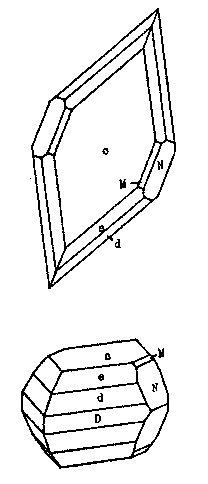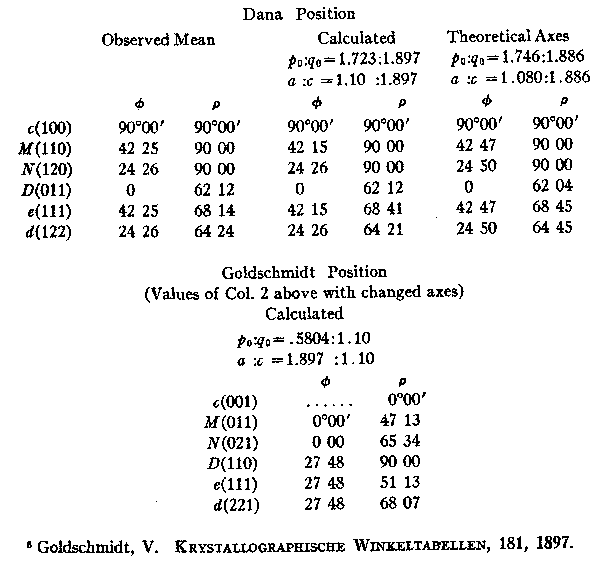| Home | AmMin | GMR | RiMG | Collectors Corner | Directory | Short Courses | |
|
|
|||||||

|
|
Volume 13, pages 349-353, 1928 NORBERGITE FROM FRANKLIN, NEW JERSEY ESPER S. LARSEN, L. H. BAUER AND H. BERMAN The mineral norbergite recently described by Geijer1 is an abundant mineral in many museums, as most of the minerals labelled chondrodite or humite from Franklin, N. J., are norbergite. All such specimens examined in the Harvard Collections proved to be at least in part norbergite. The norbergite occurs in a coarsely crystalline limestone from the Nicoll Quarry, and grains or crystals are commonly several millimeters across and some are a decimeter across. For the most part crystal faces are entirely lacking, but one crystal suitable for measurement was contained in the Harvard Collection to which it had been presented by Dr. H. Ungemach of Paris in 1906. In thin sections many of the norbergite grains show irregular, rounded to embayed cores of chondrodite and these cores suggest that the norbergite has replaced the chondrodite, though it may simply have grown about the chondrodite as a nucleus. The chondrodite is more nearly colorless than the norbergite, has little pleochroism, has a higher index of refraction than the norbergite and shows polysynthetic twinning which ends abruptly at the norbergite. In no case was the norbergite observed to be twinned. This fact leads to the conclusion that norbergite is orthorhombic. The norbergite varies in color from tawny (Ridgway's 13" j) to chamois (Ridgway's 19" b) and the lighter colored varieties have lower indices of refraction than the darker, indicating lower iron content. It has a hardness of about 5 1/2 and in general appearance resembles the other members of the humite group. The optical properties of norbergite from Franklin are similar to those reported by Geijer for the mineral from Norberg. It is optically +, 2V about 50°, dispersion slight. The indices of refraction vary somewhat; those of the darker, analyzed material are given in column 1, TABLE I, those for the chamois-colored crystals in column 2, and those found by Geijer for the Norberg mineral in column 3. The measurements of the mineral were made by the immersion method using monochromatic light and should be in error not more than ± 0.001. The norbergite is distinctly pleochroic in thin sections and, in this respect resembles the other members of the humite group. For the analyzed materials a is pale yellow, β is very faint yellow, and γ is sensibly colorless. The lighter colored varieties are more faintly colored. A sample of the Franklin norbergite containing about 2 per cent. of admixed chondrodite, was analyzed by Bauer and the results are shown in column 1, TABLE I. In column 3 the analysis of the norberg mineral by Bygden is shown, and in column 4 the composition of the theoretical molecule, MgF2 · Mg2SiO4. The two analyses are much alike and are near the theoretical composition. The Franklin mineral is high in alumina and low in water and iron. TABLE I. ANALYSIS AND PROPERTIES OF NORBERGITE.
CRYSTALLOGRAPHY. Penfield and Howe2 on the assumption that there is a regular progression in the value of the c crystallographic axis with a change in the chemical composition of the members of the humite group, predicted the axis for norbergite and later Sjögren3 gave the name prolectite to a member of the humite group from Nordmarken as a result of a crystallographic study that. seemed to show an agreement between his mineral and the mineral predicted by Penfield and Howe. Recently Geijer4 has shown that the original prolectite is identical with chondrodite.
FIGURE 1. NORBERGITE. Drawing of a crystal showing the forms c (001), M (011),.N (021), D (110), a (111) and d (221). An X-ray study of the members of the humite group by Bragg and West5 showed that the members of the humite group with 1, 3, or 5 Mg2SiO4 to 1 of Mg(F,OH)2 should be orthorhombic while prolectite with 1 molecule of Mg2SiO4 had been described as monoclinic. Our study confirms the conclusions of Bragg and West as both the optical data and the crystallographic study show that norbergite is orthorhombic. The orthorhombic development is shown by the one good crystal reproduced in figure 1. Although the crystal here studied is not suited for accurate determination of the crystallographic constants, the values actually determined are given, to be compared with those predicted by Penfield and Howe and used by Dana and others. The orientation of Goldschmidt6 is, however, preferred because his treatment of the humite group is in accordance with the results from X-ray studies obtained independently by Bragg and West. TABLE II gives the measured and calculated angles for the Franklin norbergite, as well as the calculated angles from the theoretical axes proposed by Penfield and Howe. The last column of the table is the preferred position, similar to the position given to humite by Goldschmidt. The letters assigned to the forms are those for the corresponding forms of humite as given in the Winkeltabellen. TABLE II. ANGLE TABLE OF NORBERGITE.
TABLE III gives the axial ratios compared for the three positions adopted by Dana, Goldschmidt, and Bragg and West. For norbergite the a and c axes are interchanged in the Dana and Goldschmidt positions. In the Bragg position the a axis is chosen as unity. The lengths in angstrom units are given for the members of the group, as determined by Bragg and West. The approximate interplanar spacings along the axes for norbergite should be, according to the axial ratio from the calculated values, 4.65Å:10.23Å:8.82Å. If the theoretical values for "prolectite" are used the interplanar spacing is: 4.74Å:10.23Å:8.932Å which is probably more accurate than the spacings derived from the measured values. In order to carry out the theory of a progression in the value of the c axis, the c value should probably be halved, so that c = 4.466Å. TABLE III. COMPARISON OF AXIAL RATIOS IN VARIOUS POSITIONS.
NOTES 1 Geijer, Per. Some Mineral Associations from the Norberg District, Sveriges. Geol. Unders. Arsbok, 20, No. 4, 1926. 2 Penfield, S. L. and Howe, W. T. H. On the Chemical Composition of Chondrodite, Humite and Clinohumite. Am. Jour. Sci., 48, 188, 1894. 3 Sjögren, Hj. Contrib. to Swedish Mineralogy, Bull. Geol. Inst. Upsula, Vol. I, 40, 1893. 4 Loc. cit. 5 Bragg, W. L. and West, J. The Structure of Certain Silicates, Proc. Royal Soc. London, CXIV, 614, 1927. 6 Goldschmidt, V. KRYSTALLOGRAPHISCHE WINKELTABELLEN, 181, 1897.
| |||||||||||||||||||||||||||||||||||||||||||||||||||||||||||||||||||||||||||||||||||||||||||||||||||||||||||||||||||||||||||||||||||||||||||||||||||||||||||||||||||||||||||||||||||||||

